Erica Synths Hexinverter Drum Modules
Author and photos: Peter Kaminski
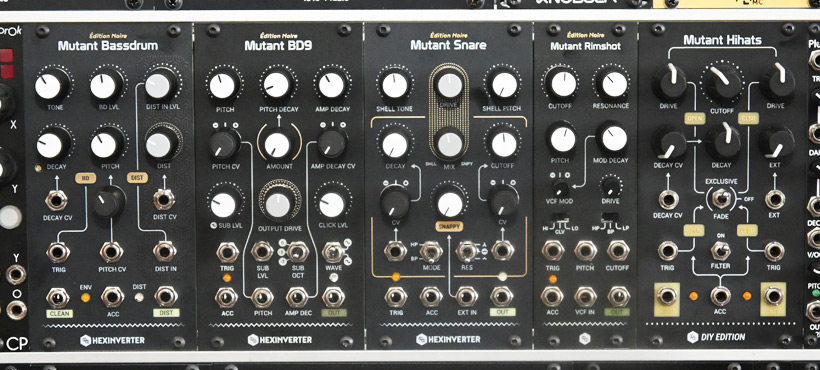
In 2022, the Canadian Eurorack module manufacturer Hexinverter ceased operations. This is a sad to hear, as many of their modules were very popular. Erica Synths took over Hexinverter's products, redesigned them to fit Erica Synths' production processes, modified the front panel design slightly, and has been offering them again for some time now.
The following six drum modules from the “Mutant Series” were included: Bass Drum, Snare, Hi-Hats, Claps, Rimshot, and BD9. The first four are also available as a Hexinverter Bundle. The front panels are made of painted fiberglass. Unlike the originals, all modules from Erica Synths are available in black as “Edition Noire.”
The inspirations
Before we examine the individual modules, we first want to take a step back in time with looking at the sound and circuitry of the Mutant Drum series. In 1980, Roland introduced the TR-808 drum machine, which was developed by Tadao Kikumoto. The sound generation was analog and included bass drum, snare, three toms, rimshot, claps, cowbell, cymbal, and open/closed hi-hat, as well as some alternative instruments such as congas, etc. The pitch and, in some cases, the decay time could be changed. Instead of pre-programed patterns, individual patterns could be programed using a step sequencer. This was also a novelty at the time and not something that could be taken for granted. The instrument quickly became an icon in music production, especially in genres such as hip-hop, electronic music, and classic pop. The instrument's influence on music was immense.
In 1981, the TR-606 was released, a significantly cheaper drum machine, but one that was also much more limited in terms of functionality. Although the volume of the individual instruments could be adjusted, no other sound changes were possible. The sound was also much thinner, and the instrument remained in the shadow of the TR-808. There are only a few replicas. In 1983, production of the TR-808 was discontinued and replaced by the Roland TR-909, which was the first Roland instrument to use samples and could also be controlled via MIDI. The sound was based on the 808, but the bass drum in particular was more aggressive and punchy, differing significantly from the typical TR-808 bass drum sound. In addition to the decay, it was now also possible to change the attack time. The TR-909 became another icon in genres such as techno and house.
Mutant Bass Drum
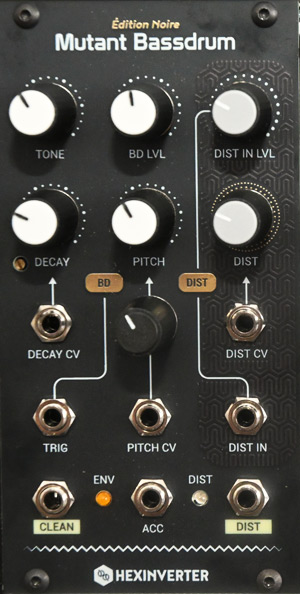
The “Mutant Bass Drum” is based on the circuit design of the TR-808. A pulse with a length of one millisecond is sent to a T-network consisting of resistors and a capacitor, generating a sine wave with decreasing amplitude. A notable feature of the original circuit is that when a trigger with accent is used, not only is the volume changed but the network is also detuned in frequency. On the original TR-808, only tone, decay, and level can be adjusted.
The Mutant Bass Drum offers a trigger and an accent input. Unlike the original, the accent input allows the accentuation to be continuously adjusted via the control voltage. The TONE knob can be used to adjust the treble content, similar to the cutoff frequency of a low-pass filter. There is also a knob for the decay time (DECAY) and bass drum level (BD LVL). These are the same knobs found on the original TR-808 bass drum.
The signal is output via the CLEAN jack. However, there is also a distortion effect. Normally, this is fed from the CLEAN signal. However, there is also an input jack (DIST IN). If a plug is inserted here, the existing connection is interrupted, and this effect can also be used for other signals. The processed signal is available at the DIST output. The DIST IN LVL knob adjusts the input level for the effects loop. The intensity of the distortion effect can be adjusted using the DIST knob.
The following parameters can also be controlled via control voltages: pitch (PITCH CV), decay time (DECAY CV), and degree of distortion (DIST CV). The input for pitch control also features a PITCH CV knob to attenuate the control voltage. Please note that pitch control is not linear, i.e., it does not have a sensitivity of 1 V/oct. The pitch control range is approximately two octaves. There are also two LED indicators: one for the envelope (ENV) and one for the degree of distortion (DIST).
Mutant BD9
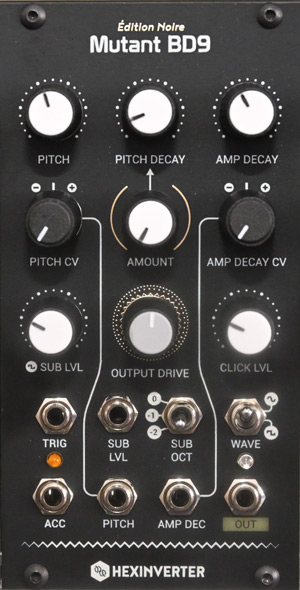
The “Mutant BD9” bass drum is an alternative to the previously presented “Mutand Bassdrum.” It is based on the bass drum of the TR-909 with its typical sine waveform, but it can also be switched to a square waveform as the signal source using the WAVE switch. The pitch can be adjusted in the range from 30 to 240Hz. Unlike the Mutant Bass Drum, the pitch can be modulated using a separate envelope generator - not via the envelope for the volume curve (AMP DECAY). PITCH DECAY sets the decay time, and AMOUNT sets the degree of modulation.
However, there are two further differences compared to the Mutant Bass Drum. There is a click generator that adds an extra attack sound via a short noise signal and a pulse. This allows you to make the sound much more aggressive. The level of the click generator can be changed using the CLICK LVL. There is also a sub-oscillator with a square waveform that can be tuned lower, as we are familiar with from synthesizers. How low the sub-oscillator is tuned can be set using a switch (same pitch or one or two octaves lower). The output level of the sub-oscillator can be adjusted using the SUB LVL knob. The OUTPUT DRIVE knob can be used to change the output level and, at higher settings, to deliberately overdrive the sound for tone shaping.
In addition to the trigger (TRIG) and accent input (ACC), the pitch (PITCH), the amplitude decay time (AMP DEC), and the output level of the sub-oscillator (SUB LVL) can be influenced via control voltages. The audio output signal is available at the OUT jack.
Mutant Snare
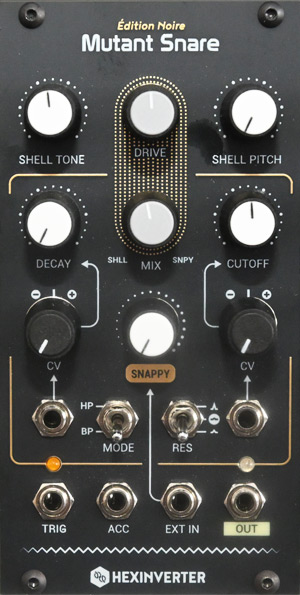
The “Mutant Snare” is again conceptually based on the TR-808. The snare sound is generated by two sine oscillators (shell component), one of which can be detuned, and a noise generator (snappy component). Instead of the internal noise generator, an external noise signal can also be fed in (EXT IN). The level of the external or internal noise generator can be adjusted using the SNAPPY knob.
The SHELL TONE knob adjusts the level ratio between the two sine wave oscillators (primary/secondary), while SHELL PITCH adjusts the pitch of the primary sine wave oscillator. DECAY adjusts the decay time, and MIX adjusts the ratio between the tonal component (shell) and the noise component (snappy). DRIVE controls the output level, with settings above the center position increasingly overdriving the signal and causing clipping.
There is also a filter for the snappy component (switchable between a 12 dB/octave high-pass filter and a bandpass filter), whose cutoff frequency can be adjusted using the CUTOFF knob. The resonance behavior can be adjusted using the RES switch, with the middle position corresponding to the resonance behavior of the TR-808 snare drum (low resonance). When the switch is set to the up position, the filter may also self-oscillate - and when the switch is set to the down position, the resonance is higher than in the middle position.
As usual, the Mutant Snare module offers a trigger and an accent input, as well as the aforementioned snappy input and the OUT jack for the audio output signal. Control voltages can be used to change the decay time and filter frequency. Both inputs have knobs for input level attenuation. There are indicator LEDs for the trigger input and the audio output level.
Mutant Rimshot

With the exception of the narrower 8 HP wide “Mutant Rimshot” module, all modules are 13 HP wide. The concept of the “Mutant Rimshot” module is again inspired by the TR-909 and is based on three oscillators formed by a pulse and an excited bridged T-network, as well as a downstream state-variable filter (switchable low-pass, band-pass, and high-pass) for sound shaping. The VCF IN jack allows an external signal to be fed in alongside the internal signal.
There is also a special mode called “CLV,” which produces the so-called “clave sound”, using only one oscillator instead of three. This option was not available on the TR-909. The other two modes, HI and LO, offer classic modes with three oscillators in two different pitches. The filter frequency can be adjusted via CUTOFF, the resonance behavior via RESONANCE, and the pitch of the oscillators via PITCH. The MOD DECAY knob can be used to change the decay time. There is also a small VCF MOD knob that can be used to modulate the filter frequency in proportion to the envelope generator. The Drive knob sets the output level, and higher values add distortion.
In addition to trigger and accent inputs and the audio output, the pitch of the oscillators and the filter frequency can be modulated through control voltage inputs.
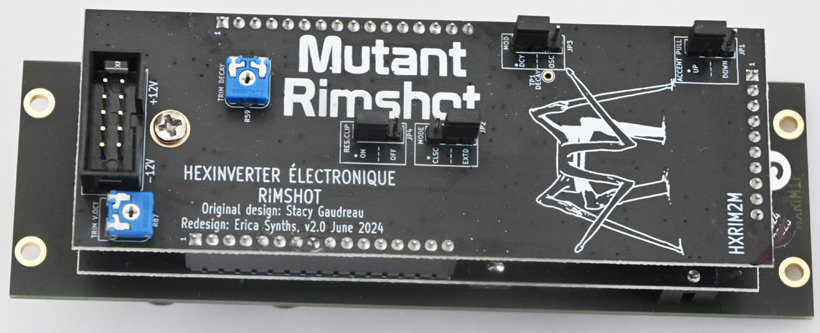
On the rear panel of the Mutant Rimshot module, there are four jumpers that allow the user to perform various preconfigurations. More on this later.
Mutant Hi-Hats
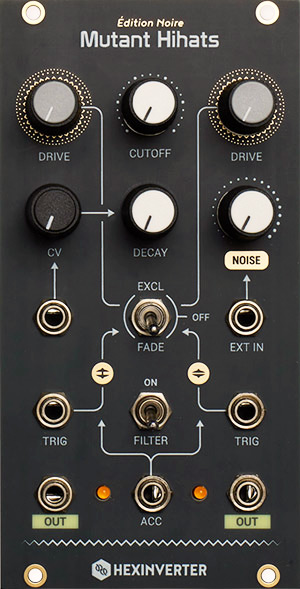
The Mutant Hi-Hats module was again inspired by the TR-808 in some respects. However, instead of the transistor-based circuitry of the TR-808, more modern low-noise op-amps or OTAs are used here. We tested the version from Hexinverter and not from Erica Synths, as we already had the module available. There are no differences in sound whatsoever. The module offers a trigger input for both the closed and open hi-hats. The accent input affects both hi-hats.
There are three different interaction modes for the closed and open hi-hats. These are selected using a three-position toggle switch in the middle of the module. The FADE mode corresponds to the behavior of the TR-808. This shortens the decay phase of the open hi-hat by triggering the closed hi-hat. In the EXCLUSIVE mode, the open hi-hat is not shortened but it is completely cut off. There is also an OFF mode in the middle position of the switch, where the open hi-hat is not affected by a triggered closed hi-hat.
The two DRIVE knobs allow you to adjust the level and, at higher values, the degree of distortion independently for the closed and open hi-hats. The filter frequency is set for both hi-hats using the CUTOFF knob, while the decay time for the closed hi-hat is fixed and can only be adjusted for the open hi-hat using the DECAY knob. Incidentally, the filter can also be removed from the signal path using a switch.
The decay time can also be modulated via the DECAY CV control voltage input. The input also has a knob that can be used to adjust the sensitivity. The EXT input can also be used to deactivate the internal hi-hat generator and instead use an external signal as the signal source. The EXT knob changes the external or internal level, depending on whether a plug is inserted into the EXT jack. It's also nice that separate audio outputs are provided for closed and open hi-hats. An indicator LED is available to visualize the audio output level.
Mutant Claps
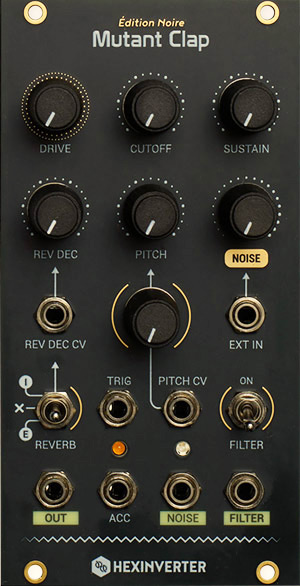
We did not have the “Mutant Claps” module available for testing, but we would still like to briefly mention it. Mutant Claps is inspired by the TR-909. The pitch can be adjusted via PITCH, the filter frequency of the bandpass via CUTOFF, the decay time via SUSTAIN, and the level and distortion via DRIVE. In addition to trigger and accent input and audio output OUT, the pitch can also be modulated via the PITCH CV control voltage input. A knob is also used here to attenuate the control signal.
A special feature is the integrated reverb effect, which can be adjusted in length using the REV DEC knob. The reverb length can also be modulated via a control voltage input. A switch allows the reverb to be inserted before or after the filter or switched off completely. The internal noise source is available as an audio signal on the NOISE OUT jack. FILTER OUT is a signal tap behind the band bass filter.
In practice
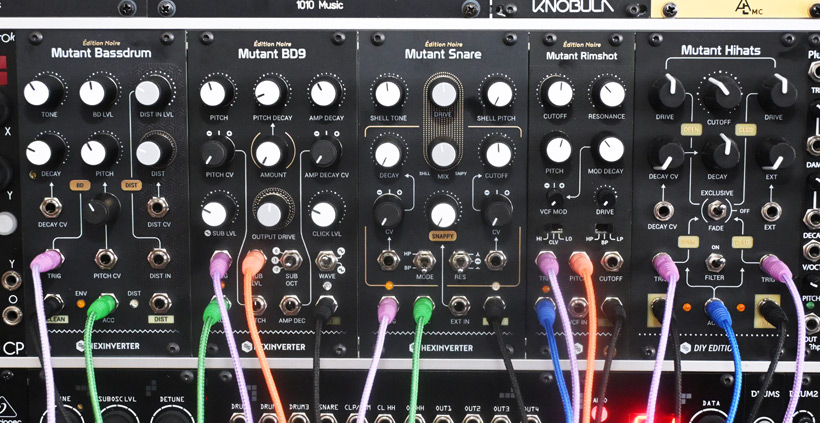
The modules' operating current is very low. We measured the highest current on the Mutant Snare at 67mA (+12V) and 62mA (-12V). On the Mutant Bassdrum, it was only 20mA (+12V) and 17mA (-12V).
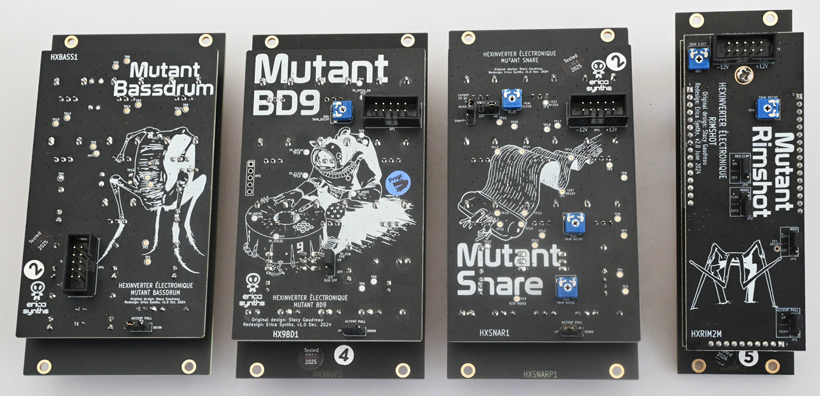
The manuals are partly available from Erica Synths, but some are only available from the Hexinverter website. There are no changes in operation compared to the Hexinverter modules. On the back of the modules are some trimmers for adjusting important parameters, which you should not change yourself, as well as the aforementioned jumpers for configuring certain functions. On each module, you can set how the module should behave without the accent plug inserted, i.e., accent minimum or maximum. The other jumpers are labeled on the back of the PCB but do not always provide clear information about their function. Unfortunately, there is very little information about this in the manuals.
In terms of sound, the modules behave essentially the same way as the original modules from Hexinverter. It is difficult to decide whether to prefer the Mutant Bassdrum or the Mutant BD9, as the two sound very different and offer completely different settings. The Mutant Bassdrum tends to have a more boomy sound, while the BD9 focuses more on the adjustable click and frequency modulation via the envelope. When using the sub-oscillator and switching to the square waveform, depending on the settings, the BD9 sounds very different from a classic bass drum, which, of course, makes the module more interesting. However, those who want a broader sound will probably appreciate both modules.
The snare and rimshot can also be used to create classic sounds à la TR-808 and TR-909, as well as sounds that are far removed from these. With the Mutant Rimshot module, for example, you can also create claps by activating the clave mode. The adjustable tonal range of the modules is really very wide.
We can't say much about the claps, as we didn't test this module. If you're looking for a hi-hat drum module that also masters open/closed hi-hats perfectly, the Mutant Hihats module is the right choice. This module was actually the reason I started looking into the Hexinverter Mutant series - and the other Erica Synths modules were added later and complement each other perfectly. Even though the Mutant drum module series can do a lot more than just normal acoustic drums, the Perkons Voice module from Erica Synths, which we also tested, is definitely an ideal addition for even more sonic flexibility. The “Toms” module from Erica Synths can also be a useful addition to a larger drum set.
Conclusion
The Hexinverter Mutant drum modules are available for just under 200 euros each, except for the rimshot module, which is available for 190 euros. The Mutant Bundle, which consists of a bass drum, snare, clap, and hi-hats, costs approximately 700 euros. Personally, I find the Hexinverter Mutant series extremely successful. It is not limited to the classic TR-808 and TR-909 sounds, but is much more flexible in terms of sound design.
 How to resolve AdBlock issue?
How to resolve AdBlock issue?